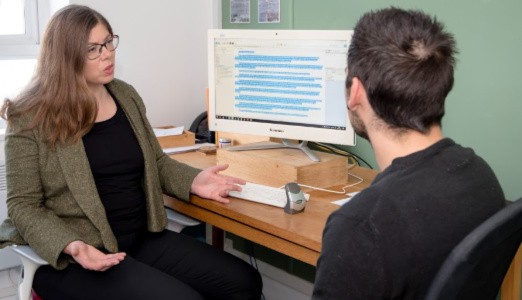
Sales funnels for online products
When you’re selling online products or lower value services, you’re going to need a lot more people coming in to make it worthwhile for you to do all this work. So you can’t spend so much time per lead.
You’re going to need an automated sales funnel to handle this kind of volume. This means setting up an email series. This is much more successful than social media, advertising or retargeting Facebook ads, because you already have a relationship with that person through regular emails.
An automated email series is also useful when you’re selling high-value services to people who are not on your A list. So you can automate keeping in touch with the people who are a little less likely to buy from you or are less likely to buy right now.
Most people I talk to are either completely new to the idea of a sales funnel by email. Or they’re already using email a little but sending out email newsletters which they write just before sending out.
Maybe you’ve got a list you’ve collected already or you’re sending out a regular email newsletter or you have an automated email series in place. The next part of this article is what I’ve learnt the hard way about sending out emails to leads.
The different stages of the sales funnel
Sales funnel stage 1 – Welcome
The first stage of meeting a new lead is important. When you meet someone, you want to get across what it is that you do. And the benefits you bring with the work you do for clients. Especially the benefits.
If I lazily tell you that I’m a business coach, you’ll instantly pigeonhole me. You’ll file me in your head with my competitors, and the business coaches you’ve met before.
If I tell you that I help people to make more money and have more fun by giving them everything they need to run a successful business, that’s much more attractive. And it’s what I do, the coaching, business advice, programmes and books are just how I do that.
If you met a gardener, she wouldn’t tell you that she was a person who used a spade, would she? So don’t focus on how you do your thing, or the tools you use – tell them about the outcomes people get from working with you first.
Here are some thoughts on how to have a hot elevator pitch, which you can also use to focus your mind on getting across the benefits and outcomes to your potential clients at the beginning of your sales funnel.
And if you haven’t worked out exactly who you want to attract, this is a handy guide to developing your customer avatar.
You also want to get across some of your brand friendliness. Make it clear that you are happy to talk to them and interact. And start encouraging interaction and engagement right from the start.
But don’t bombard people with how great you are, and all the cool things you can do with them. With our dating analogy, this would be like meeting someone in a bar, and telling them how great you are in bed. Be friendly, be interested in them, and be useful.

Asking people questions, getting their opinion and sending them great stuff is all part of the process of nudging people down your sales pipeline. All these steps bring them closer to the point where they book you to do some work or buy one of your products.
Sales funnel stage 2 – Qualify and segment
We’ve already talked about the A list for high-value services. When you’re taking a more manual, individual approach to your sale funnel you will want to qualify your leads in some way. Your criteria might look something like this:
- Do they sound keen?
- Have they been referred by someone else, especially someone who has sent you high quality leads before?
- Are they a good fit for you? That is, could you help them in some way?
- Do they look like they have some budget to spend?
My confession
I look at a potential client’s website, their LinkedIn profile, and other social media to get an idea of whether they’d be a good fit for me.
Partly this is to judge if I can help them, and partly it’s just research to find out more about their business before I talk to them.
But one time, I had very little information about a new client, but I could see his home address. I googled this and found through Zoopla that his house was worth nearly a million so I ensured I made a special effort to talk to him.

When you’re working on an automated sales funnel for online products or just bringing in new leads through your website, you’ve often not got a lot of information to qualify people on and see which ones are more of a target for you.
It can be tempting to send out the same nudges and nurturing emails to everyone. And there’s nothing wrong with this at all. If you’re just getting started, it’s much better to start building your list and engaging with potential people.
Don’t make your sales funnel too complicated
It’s tempting to get overly complicated with your sales funnel too early, then never getting round to completing it and that way you end up not talking to anyone.
Don’t try to run before you can walk – just write six good emails with useful, engaging content, and send those out once a fortnight to the people who join your list.
That gives you 12 weeks to write some more emails and to start delving into a more sophisticated approach.
There’s more information below on how to write those emails, and get your list of lovely new people engaged at an early stage.
You can qualify people even if you’ve never actually talked to them, and only have their email addresses, simply by seeing if they read your emails. This corresponds to the “do they seem keen?” criteria above.
I use Drip email for sending out automated emails. Drip was my upgrade from MailChimp, which is fine for sending out one series of emails, but didn’t give me enough flexibility to be able to send out different emails to different groups of people.
In Drip, I can see who has been reading my emails the most, who is most likely to buy something from me. And who it might be good to send some more lovely content to, so I can engage them even more.
Sales funnel stage 3 – Make friends
Remember that the aim of this is not to just talk about you and what you sell. We want to make friends, to get the lovely people on your list to love you, trust you and come to you first when they’re ready to buy.
When you think of how people buy, they’re always making an emotional decision. Sure, we tell ourselves that we’ve made a rational decision on which video hosting software or new shoes to purchase, but we’re human. And human behaviour is not rational.
Your potential customers are much more likely to buy from you if they think well of you. If they regularly hear from you with interesting, useful content, written in a friendly accessible way, they will be much more likely to buy from you and recommend you to their friends.
And if they regularly click through to your website, take a quiz or survey, or email you back because you’ve asked their opinion on something, they’ll be much much more likely to buy from you.
You probably send interesting snippets to your friends and family. A friend might say to me:
“Hey, Julia, here’s a website with easy vegetarian Japanese food recipes you might like…”
Because they know that I’m trying to learn how to cook Japanese food. Or they’ve sampled my attempts so far, and desperately want me to get better at it.

“Hey Julia, here’s a report on how pension funds are forcing the companies they hold shares in to be more environmentally conscious”.
This is a real one that someone sent me yesterday because they know that I’m interested in business, the economy and green politics.
Think of your potential customers as your friends, and send them the content that they are going to find useful.







